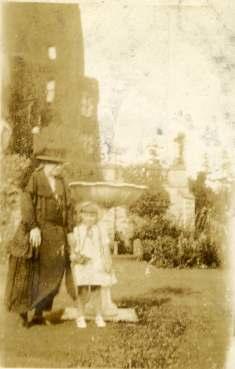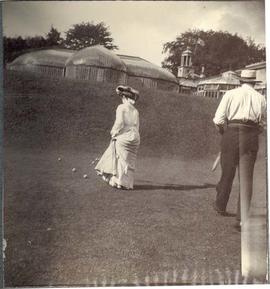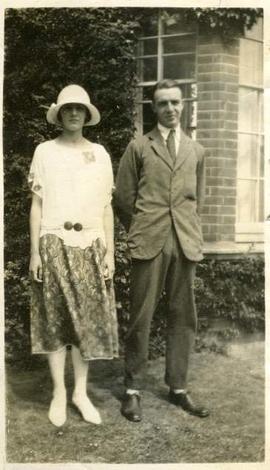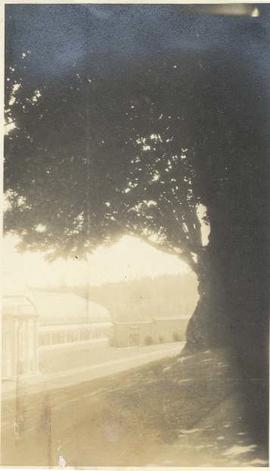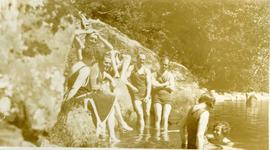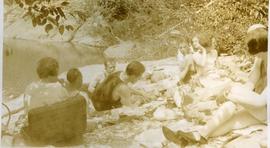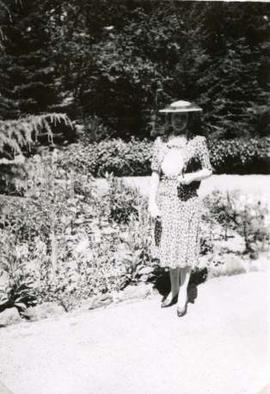Mrs. Laura Dunsmuir and F.D. Little, standing on porch at Cowichan River property.
Mrs. Laura Dunsmuir and Elinor Dunsmuir, standing among tall trees, Mrs. Dunsmuir holding umbrella. 1930s
Image is taken at Dallam Hall, Cumbria, UK, home of the Bromley family. Laura Mary 'Maye' Dunsmuir married Arthur Bromley in 1904. Visible in the background is the estate orangery.
Image is likely taken at Dallam Tower, Cumbria, UK, home of the Bromley family. Laura Mary 'Maye' Dunsmuir married Arthur Bromley in 1904.
James (b. 1903) and Laura Audain (b. 1909) are the children of eldest Dunsmuir daughter, Sarah Byrd (Byrdie) and Guy Audain.
Cropped version of 1-02-011 showing close up of Laura and Elinor Dunsmuir at Hatley Park property in 1930s.
No date information given. No authority information given. Possibly a student project/later library display. Floor plan of library showing all 3 floors. Typewritten history of the library on back. 1 page.
The walled garden was added as part of extensive development of the estate by Boston based landscape architects, Brett and Hall from 1912-1914. The walled garden contained vegetable and fruit crops as well as the greenhouse complex.
Sarah Byrd 'Byrdie' and Guy Audain are number 40 and 39.
Dola Dunsmuir and Henry Cavendish are present. Henry 'Dish' Cavendish was married to Dola Dunsmuir from 1928 to 1934.
Henry Cavendish, married to Dola Dunsmuir from 1928 to 1934, is third from left
June 21 1990. Electrical, planting and irrigation drawings. 2 stapled pages.
Robert Lee Lamont attended Royal Roads Military College from 1975-1977. Born in 1958, he joined the Air Force and was training at CFB Moose Jaw when he lost his life in a crash during a routine solo mission near Coderre, SK on 16 April, 1980.
La Salle Flight, 1956 Hessin, front row centre
Photos of Dunsmuir family members at Hatley Park and other locations. Some formal portrait photos are included.
Dunsmuir FamilyThe images are from Laura Catterall Ferguson’s family album. The images mostly concern the construction of Hatley Park and the Catterall’s residence on the property during construction. Head contractor Thomas Catterall’s son, Harry, also worked on the project and lived on site with his wife Ada (Gladding) Catterall. Their two young children, Helen and Tommie were also on site. Tommie Catterall also worked for the Dunsmuirs at Hatley Park as a general handyman in the 1930s and there is an oral history interview with this Tom Catterall available in the archives. The photocopied album pages from where the images were scanned contain useful contextual information about the family and the timeline for construction.
Catterall FamilyIn 1913, James Dunsmuir acquired a wooden structure created by the Kwakwaka'wakw people to be used as a gate entrance to the Japanese garden. The sculpture was carved from western red cedar and had three upright pieces joined by a horizontal lintel. The sculpture was located at the Dunsmuir property from 1913-1938. The posts were originally intended for the inside of a house in Dzawadi and were carved around 1884, but the house was never completed and the house posts were left until they were bought by a collector who later sold them to James Dunsmuir. Dzawadi is about 100km northeast of Alert Bay and within the traditional territory of the Da’naxda’xw Awaetlala First Nation. This images shows the house posts in their original location.
In 1938, after Laura Dunsmuir’s death, the posts were sold to George Heye, who was a well-known collector of anthropological and archeological artefacts of the Americas. The posts were part of the collection at the Museum of the American Indian in New York until 1975 when they were bought by the National Museum of Canada.
A conservator's report from the Canadian museum shows that the posts were damaged before they were positioned at Hatley Park. Careful restoration work had occurred when the house posts were relocated to the Dunsmuir estate. New wood pieces had been skillfully added to replace damage caused by a grass fire in its original location. A second, less careful restoration took place sometime after 1936, provable by the fact that pages of newspaper from that year were found used as filling material under a crude plaster and papier mache repair.
